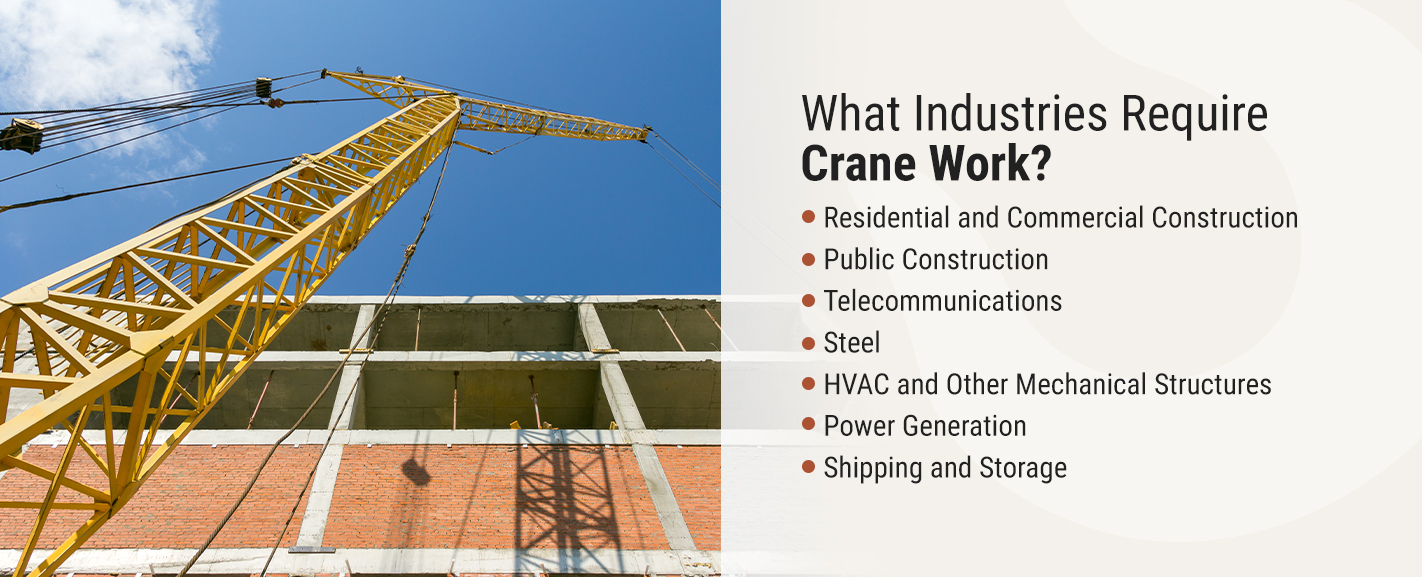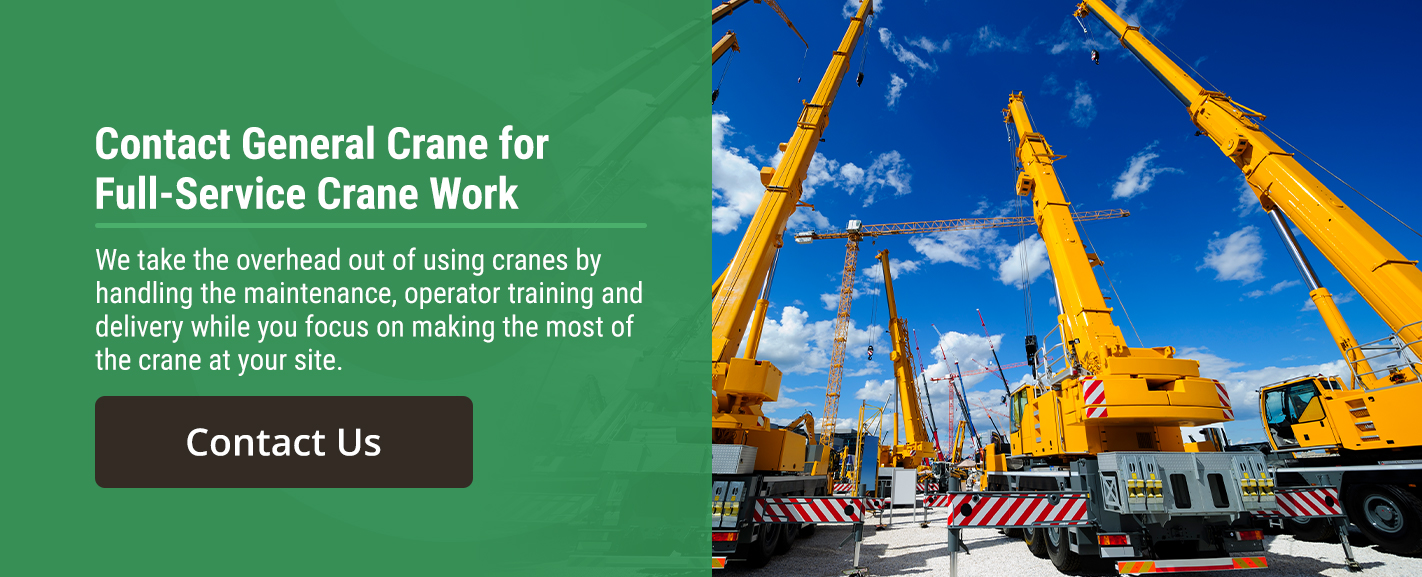7 Industries That Use Cranes
The crane industry is likely to grow due to the increasing demand for cranes in construction and other industries. Consequently, businesses that need cranes will have many companies to choose from for their rentals. Cranes are so vital to modern society that few industries would be able to do their jobs without these lifting tools. Uses of these towering tools go beyond basic construction, though. Cranes can offer the heavy lifting for businesses in many sectors.
What Industries Require Crane Work?
The versatility of cranes makes them capable of fulfilling the needs of several industries. Crane industry services include renting cranes for moving heavy materials and aiding in construction. Specific uses of cranes depend on which industry rents them.
1. Residential and Commercial Construction
Residential construction companies can benefit from rental cranes on site. Since building projects can include multifamily homes, modular construction projects and single-family units, a crane allows crews to move heavy equipment or lift materials to higher floors. Even for single-story home construction, cranes can assist with site preparation by removing trees and aiding concrete pouring.
Another application of a crane for construction is for commercial projects. Since many commercial buildings have larger dimensions than residential homes, construction projects often need to reach greater heights. On-site cranes help complete these projects quickly and efficiently. For example, cranes can move steel beams and roof trusses around the worksite or upper construction levels. Additionally, they can transfer large electrical or HVAC equipment to the roof or attic level safely.
Both residential and commercial construction projects may require tree removal as part of the site preparation for their projects. For these types of projects, a crane is needed. A crane can pull a fully grown tree and move it from its site for relocation or to save on the cost and mess of cutting the tree down. Transplanted trees from other sites require large cranes to support their bulk and lower them gently into the prepared planting hole. Well-trained crane operators can accomplish these tasks through their expert maneuvering of the crane’s controls.
2. Public Construction
Public construction projects often have constraints on the amount of ground space available for work, especially if the project occurs along major thoroughfares. Blocking lanes for construction work often requires special permission from the city. And the city may have requirements for how many lanes of traffic construction work can block and at what times. Therefore, using the smallest footprint for these types of construction projects can be less disruptive.
Implementing overhead cranes for moving equipment and lifting building parts can solve the issue of needing more space. However, for work in public locations, construction teams must use additional precautions, especially with crane work. For instance, safety regulations for these types of projects may be tighter due to local requirements. Accident prevention and highly trained operators can ensure incident-free construction at public commercial construction sites.
3. Telecommunications
The growing need for telecommunications networks means that this sector will consistently use cranes. To build the towering structures required for relaying cell signals, construction teams need cranes. Using a crane for cell towers allows the team to execute all segments of the construction efficiently. For instance, a crane can help lay the concrete foundation, erect the tower and install the antenna system on top.
Even after construction, the telecommunications industry may still require cranes for tower maintenance and repair. Towers that need inspection or individual repairs may need cranes to lift repair personnel to the site. For moving equipment required for upgrades, a crane will provide the additional lifting force needed. Lastly, the old towers that require removal will require a crane for deconstruction and safe removal of their components.
These tasks would not be possible without the powerful lifting capacity of cranes.
4. Steel
Steel construction could not happen without the lifting power of cranes. Building with steel includes commercial and occasionally residential construction. However, it also includes the erection of cell towers, bridges, industrial facilities and overpasses. On all these projects, a crane for steel movement and lifting is necessary to get these jobs finished on time and safely.
Another aspect of moving steel includes placing large steel signs for businesses. Since many of these signs have integrated electrical connections for lighting, they need care during movement and placement to ensure that they will work when connected to a power source. An expert crane rental provider can determine the type of crane required for placing a steel sign. And a professional operator can safely maneuver the sign into place without damaging the sign or surrounding structures.
5. HVAC and Other Mechanical Structures
Air conditioning units or furnaces can weigh thousands of pounds. And many units sit on roofs of homes or businesses. To move these weighty units into place, contractors need to rent a crane for HVAC placement.
Additionally, other mechanical projects that require the extra assistance of a crane include moving water heaters, installing septic tanks, moving industrial-grade equipment to roof-tops and more.
6. Power Generation
Power generation and transmission rely on a large network of lines and the towers that support them. For placement, repair or deconstruction of these electrical towers, cranes can help. When a company uses a crane for power lines, they can install or remove poles that support the lines. Additionally, they can construct large steel distribution towers. For replacing transformers, a crane can bring the unit up to the tower location. For emergency work after inclement weather, rental cranes can make restoring power faster by supplementing a power company’s existing fleet of boom trucks and cranes.
Because power lines may have power during maintenance, a crane operator must use extra caution to avoid contacting the power lines or bringing the top of the crane too close to the lines. Highly trained operators with clean safety records are required when using cranes with power generation businesses.
7. Shipping and Storage
Shipping crates or storage containers sometimes need moving around a warehouse or distribution site. To get these heavy, bulky pieces into place, cranes are crucial. To avoid damage to products that could cost a storage or shipping company in liability, the business needs a crane operator who puts safety first. With crane rental that includes trained operators, shipping and storage companies get the safety and skill they need for moving goods.
Contact General Crane for Full-Service Crane Work
For more information on how overhead crane industries can benefit your business or to request full-service crane work, contact us at General Construction Crane Service. We take the overhead out of using cranes by handling the maintenance, operator training and delivery while you focus on making the most of the crane at your site.






